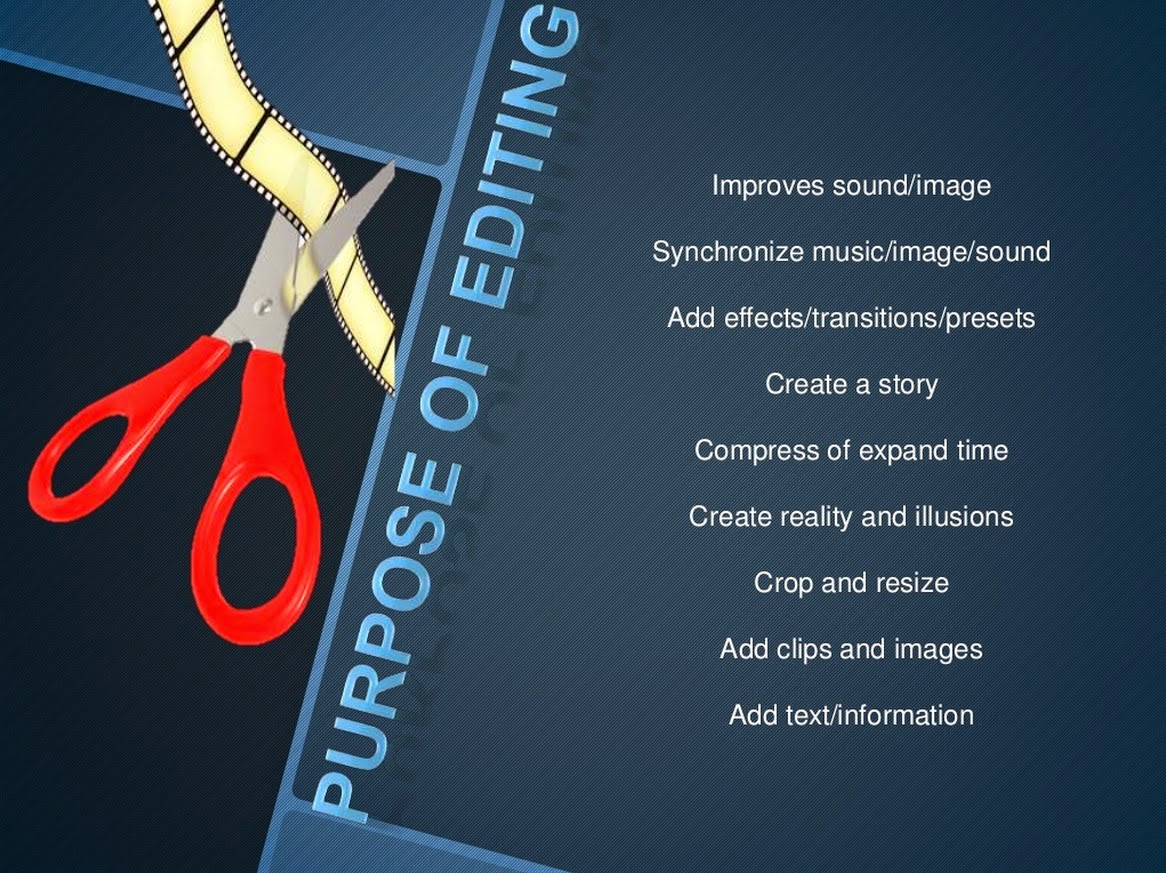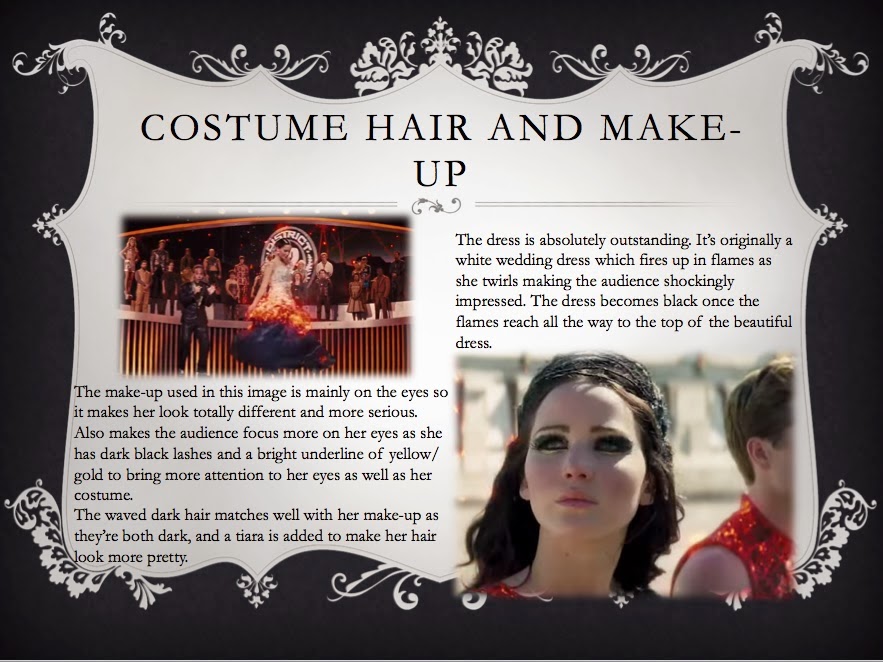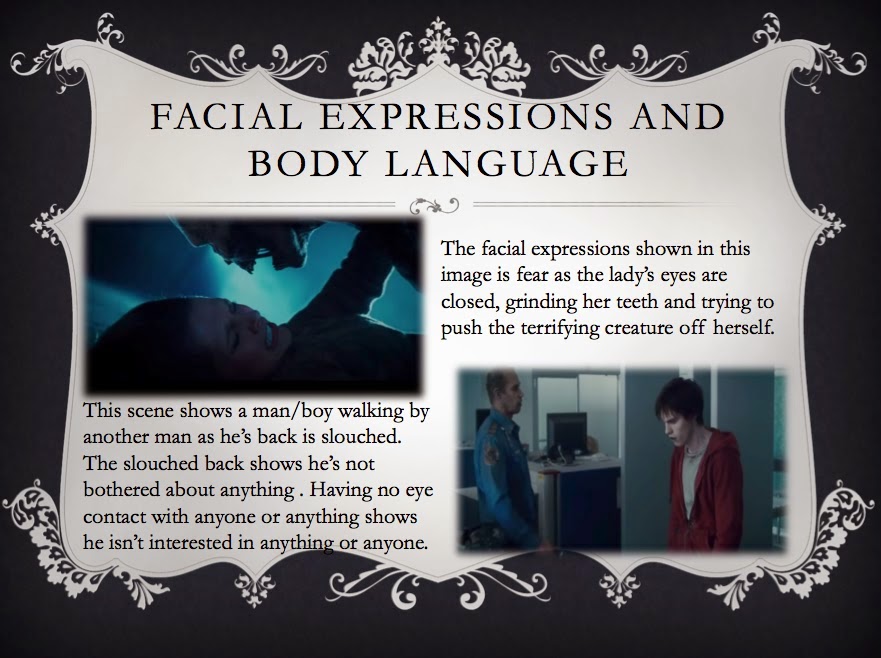Thursday, 18 December 2014
Thursday, 4 December 2014
Talking Head for Stay Alive
TALKING HEAD FOR
The film that I will be analysing is Stay
Alive which is a horror/thriller film released in 2006. It was
directed by William Brent Bell who co-wrote it with Matthew Peterman. The film
was produced by McG and
co-produced by Hollywood Pictures. This was the first
film in five years
released by Hollywood Pictures and is set in the United States.
Synopsis
A group of friends find themselves playing a underground horror game. The answer to the mysterious death of their old friend lies within the world of an online video game based on the true story of an ancient noblewoman known as the Blood Countess. The action taking place on their computer screens becomes a terrifying
reality when they realize that each time a character dies during the
game.
The Characters
Hutch (Main character/Hero)
Abigail (Girlfriend/Helper)
Swink (Helper/Friend)
October (Friend)
Phineus (Octobers brother/friend)
Elizabeth Bathory (Villain)
Loomis (Hutch's Best friend)
Fidget (Game seller)
Opening Scene - Video link 1:02 - 1:45
The opening scene starts off with a sudden extreme close up shot of a creepy eye with blood all over and then cuts into a long establishing shot of the dark, deserted mausoleum and everything around it, followed by the gloomy, negative weather which is all computer generated. It zooms in at a medium pace from a establishing shot to a long shot all the way to the front door, which then is a close up shot of the player/man entering the mausoleum.
At the beginning of the scene there is a sudden loud scream and glass shattering sound as the eye is shown. Both diegetic and non-diegetic sounds are used in this scene, for example the sound of foggy clouds whooshing past, which is a diegetic sound as you see the misty clouds while the camera zooms past. And the non-diegetic sound of a violin being used as the camera zooms down to the house from the clouds. The sound of the violin becomes faster and faster, which makes it sound very dramatic and also makes the scene look extremely thrilling as the camera reaches the door.
There is low key lighting used in the scene to create mystery. A mixture of black and grey colours are seen followed by misty white clouds which act as a frame to bring out the darkness.
The graphic display at the very beginning of the scene makes sure the audience know all the most important details such as the name of the film and the producers, directors, writers, characters, costume designers and make-up artists etc.
Second Scene - Video link 0.00 - 0.27

As the lift bell rings the scene cuts into a long shot of the lift doors opening and Hutch (Main character) walking out quite fast, almost towards the camera and walks right past which is a mid-shot of him.

From a mid shot it becomes an over the shoulder shot since the camera is behind the character facing the same direction the he is.

As Hutch walks through the corridor the camera follows him from behind at a medium pace. This is a tracking shot which gives the audience a detailed tour of where he is heading.
There are many sounds in this scene overlapping such as telephones ringing, people/officers chattering, cameras shuttering and a lady crying in pain which makes it sound awfully busy and intense. There are more diegetic sounds in the scene as you see the lift and the sound it makes once the doors open, many people talking to one another followed by the lady crying, but there are also some non-diegetic sounds for example you don't see any telephones or the camera/camera flashes.
Third scene - Video link - 0.02 - 0.06
This is a reverse angle shot of Swink trying to stop the van doors from closing. and also shows the van and Swink from two perspectives.
The camera quickly shows a shot of him from the front and then the same shot from the back.
Conflict Scene - Video link - 0.28 - 1:41
This is the climax of the conflict in the scene, the only way to destroy the villain. This scene uses a close up shot of Hutch to show his facial expression which is extreme anger as he's eyes squint and mouth opens as wide as it can to release his anger.

The colour used in this scene is orange because the room is on fire so it reflects on the characters face and the walls. This is a low key lighting as it is quite dull.

Here is a close up shot of Elizabeth Bathory (villain) burning to death which means it is finally over.
The colour used here is yellow and orange since the fire has taken over the whole scene and also acts as a frame around the character.
This is an establishing/long shot which shows the the 3 characters Hutch, Abigail and Swink leaving the graveyard while the camera slowly pans down for them to walk towards.
The shot also shows the location of where they are and the entire tower which is on fire while the ash is burning out the tower to symbolise the death of Elizabeth.
The very final scene shows the Stay Alive game beginning the same way it began in the opening scene, except this time it is seen from the a computer monitor showing the same long shot of the Mausoleum.
This is a point of view shot because Fidget (Game seller) is watching the monitor the same way the audience see it.
The camera zooms in closer at a extremely slow pace all the way into the computer making it seem like the audience is in the game.
It then pans up as it zooms to the tower where Elizabeth Bathory is looking out the same tower window where she was burnt to which means
the curse has began all over again...
Thursday, 20 November 2014
Narrative Theory - Opening/Final scene of Stay Alive
Propp
Loomis Crowley (Victim) - A young man with black hair and big glasses who looks terrified and freaked out through out.
Couple (Friends) - A couple who are friends with Loomis. They don't survive long enough in the film to talk about, there only purpose is to die.
Hutch ( Main character/Hero) - Man with light hair and not in the scene long enough but he's chilled out
Elizabeth Bathory (Villain) - Scary pale face, pitch black eyes with a bright red dress spotted in the game and also in reality.
Barthes
There is a puzzle at the start of the film. It makes you think, what has the game got to do with the film? Why is he playing it?
Barthes
The audience soon find out the characters in the film are living the game.
 |
| In the game |
 |
| In reality |
Throughout the film you realise the characters are dying the same way they die in the game which means if 'you die in the game you die for real'.
Establishing Mood
The mood is established through the dark colours and creepy music followed by the deserted location and the gloomy weather. There is a slightly surreal feeling because the opening is a computer generated game. There is dramatic sound in the beginning and also sounds of footsteps in a quiet place which makes it more thrilling.
Throughout the film you realise the characters are dying the same way they die in the game which means if 'you die in the game you die for real'.
Establishing Mood
The mood is established through the dark colours and creepy music followed by the deserted location and the gloomy weather. There is a slightly surreal feeling because the opening is a computer generated game. There is dramatic sound in the beginning and also sounds of footsteps in a quiet place which makes it more thrilling.
Loomis the gamer has played and died in the game, you can tell he is quite terrified as he gulps and stares at the computer screen, well he should be because he is about to become the first victim to be killed the exact way in the game.
It is completely dark in the house with loud sounds of thunder and the bright flashes of lightning through the window it makes the scene more intense and dramatic. The creepy sound used throughout is the vibration of the game console which is only played when Elizabeth Bathory is near.
Credits/Event signifiers
Stay Alive implies that people are going to be struggling to do just that.
Pace
The pace of the beginning is edited and shot extremely well, as it is computer generated and then goes back straight to reality. This way you know when your in the game or when it's actually happening. The editing includes some quick cuts for example when the player in the game is trying to escape the house, and some slower pace sections when Loomis is slowly moving around the house while he's scared.
The Final Scene
Propp
Elizabeth Bathory (Villain) - Her extremely pale/white face and pitch black eyes are clearly spotted while she is on fire as she hits the floor and burns to ashes.
Main character/Hero (Hutch) - A terrified angry man who is shown as a a little boy constantly crying and screaming with anger as this reminds him of a bad childhood memory when he's mother was also burnt in a fire.
Abigail (Girlfriend/Helper) - Pretty girl with messy blonde hair reaching out to help Hutch while she is injured and petrified.
Swink - His bright blue eyes which stand out through the blazing fire also covered in dust and ash as he kicks the door open and also reaches out to help Hutch .
Game seller - Man with scruffy brown hair and painted nails looks very interested and excited to launch and play the game in his store.
Todorov
In the closing scene of Stay Alive Hutch finally finds Elizabeth Bathory in the tower and sets the whole room on fire. Elizabeth catches fire and burns while Hutch and his two friends Abigail & Swink pull him out the tower and escape the mausoleum.
In the very last scene the computer game Stay Alive has been launched in a game store as the seller himself begins to play the game. This means he and anybody else who purchases and plays the game are on the road to death.
Barthes
The puzzles are resolved as the villain is found in the actual tower/mausoleum from the game and she dies as she is burned to death. There is also a very good action sequence involved here which symbolises evil being consumed by the powerful element of fire. It also symbolises the power of friendship.
Levi - Strauss
In the opening scene oppositions are established. A fight between good and evil, real and the unreal, life and death. For example Loomis is a normal guy doing he's thing but he is killed by an evil woman.
Thursday, 23 October 2014
Wednesday, 22 October 2014
Thursday, 16 October 2014
Analysis of Sherlock Holmes opening scene
Clip of the opening scene of Sherlock Holmes.
In this short opening to Sherlock Holmes I picked out all the different sounds being used such as:
- A piano
- Horses and carriages
- Fire flames
- Crow
- Guns clicking
- Glass shattering
- Doors creaking
- Violins
- Gunshots
The scene starts of with a piano playing which slowly becomes louder and louder. As the clip moves on the different sounds blend and start clashing together which makes it extra dramatic.
The scene gets more intense from the middle to the end as the music speeds up making it sound more interesting and thrilling.
There are diegetic sounds used where you the objects are visible and heard. For example the sound of the horses and the carriage are included in the clip. The flames from the fire are heard and seen also the door opening and a crow flying past making noise.
However there are non-diegetic sounds such as the piano through out the whole scene and the violin followed by the glass shattering everywhere. These sounds are only heard but not seen in the clip.
Glossary
Diegetic - Sounds that are visible in a video and heard.
Non-Diegetic - Sounds that are NOT visible but are heard in a video.
Ambient - Surroundings of something immediate.
SFX - Sang word for sound effects.
Mood - Happy, sad etc. depending on the music or genre of the movie/scene.
Tone - Soft, gentle, harsh, severe etc.
Genre - Romance, Horror, Thriller, Action etc.
Theme music - Music that represents the movie for example James bond movie theme.
Voiceover - Additional voice is added to a soundtrack (Non-diegetic).
Musical Score - The musical script (dialogue goes through the whole film).
Synchronous sound - Something that occurs at the same time (same rate)
Contrapuntal - Two ore more independent melodies sounded together.
Silence - No sound (silent movie)
Selective sound - Used to highlight key things
Sound bridges - Music that links one scene to another.
Thursday, 2 October 2014
Thursday, 25 September 2014
Stay Alive trailer analysis
Stay Alive Trailer
I am going to analyse the trailer of the movie called Stay Alive. It is a horror/thriller which was released in the U.S on the 24th March 2006. The movie has a variety of settings which includes a mansion, houses, office and the main location a large creepy Mausoleum with a Black tower.
Although the movie is mainly based in the creepy Mausoleum it has a huge part in a computer game called Stay Alive which has the exact same Mausoleum. It is based on a story of a woman in a red dress called Elizabeth Bathory who is the person who kills anyone who can't survive. Once you start playing the game and if you somehow manage not to stay alive you will die exactly the same way in reality.
Looking at the terrifying building and it being deserted shows that the house had a horrifying history. Also the dark stormy clouds all around it symbolise that nobody is welcome and if so there is trouble to come.
Subscribe to:
Comments (Atom)
%2Bdergfds.jpg)

































